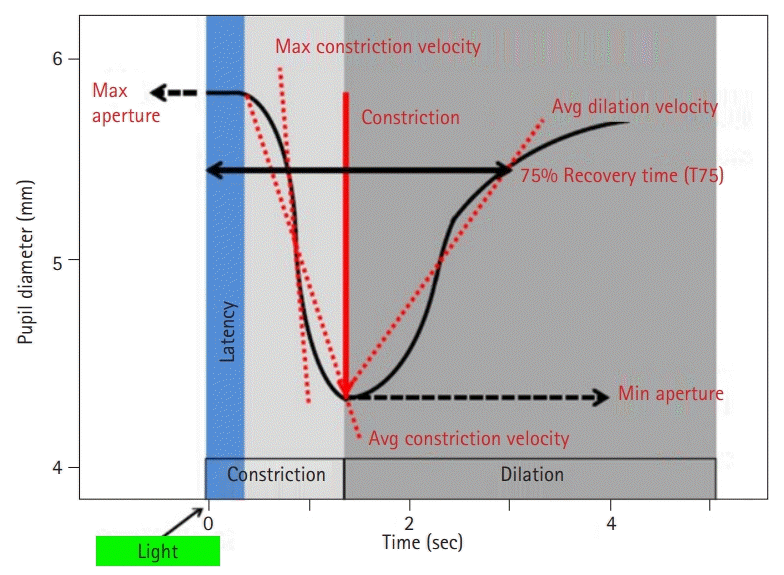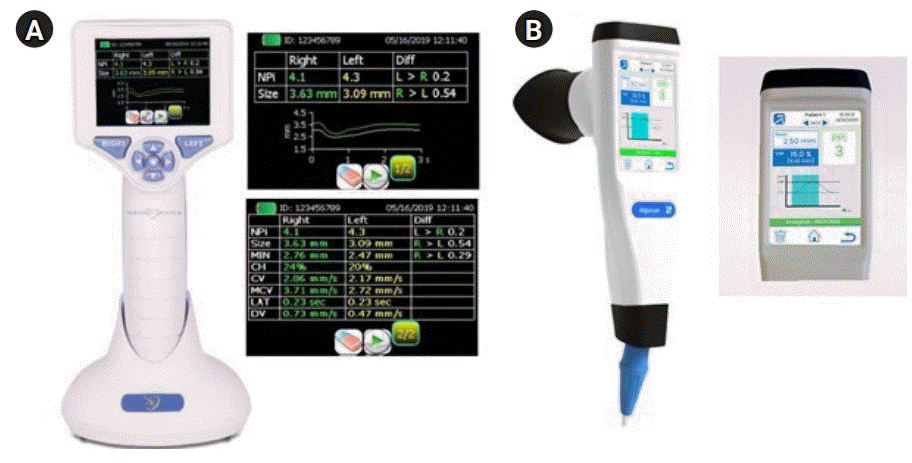1. Dowlati E, Sarpong K, Kamande S, Carroll AH, Murray J, Wiley A, et al. Abnormal neurological pupil index is associated with malignant cerebral edema after mechanical thrombectomy in large vessel occlusion patients. Neurol Sci. 2021; 42:5139–48.

2. Larson MD, Singh V. Portable infrared pupillometry in critical care. Crit Care. 2016; 20:161.
3. Larson MD, Behrends M. Portable infrared pupillometry: a review. Anesth Analg. 2015; 120:1242–53.
4. Bower MM, Sweidan AJ, Xu JC, Stern-Neze S, Yu W, Groysman LI. Quantitative pupillometry in the intensive care unit. J Intensive Care Med. 2021; 36:383–91.

5. Taylor WR, Chen JW, Meltzer H, Gennarelli TA, Kelbch C, Knowlton S, et al. Quantitative pupillometry, a new technology: normative data and preliminary observations in patients with acute head injury. Technical note. J Neurosurg. 2003; 98:205–13.
6. Zafar SF, Suarez JI. Automated pupillometer for monitoring the critically ill patient: a critical appraisal. J Crit Care. 2014; 29:599–603.

7. Lussier BL, Olson DM, Aiyagari V. Automated pupillometry in neurocritical care: research and practice. Curr Neurol Neurosci Rep. 2019; 19:71.
8. Rasulo FA, Togni T, Romagnoli S. Essential noninvasive multimodality neuromonitoring for the critically ill patient. Crit Care. 2020; 24:100.

9. Oshorov AV, Alexandrova EV, Muradyan KR, Sosnovskaya OY, Sokolova EY, Savin IA. Pupillometry as a method for monitoring of pupillary light reflex in ICU patients. Zh Vopr Neirokhir Im N Burdenko. 2021; 85:117–23.

10. Park JG, Moon CT, Park DS, Song SW. Clinical utility of an automated pupillometer in patients with acute brain lesion. J Korean Neurosurg Soc. 2015; 58:363–7.

11. Osman M, Stutzman SE, Atem F, Olson D, Hicks AD, Ortega-Perez S, et al. Correlation of objective pupillometry to midline shift in acute stroke patients. J Stroke Cerebrovasc Dis. 2019; 28:1902–10.

12. Kim TJ, Ko SB. Implication of neurological pupil index for monitoring of brain edema. Acute Crit Care. 2018; 33:57–60.
13. Zhao W, Stutzman S, DaiWai O, Saju C, Wilson M, Aiyagari V. Inter-device reliability of the NPi-100 pupillometer. J Clin Neurosci. 2016; 33:79–82.

14. Olson DM, Stutzman S, Saju C, Wilson M, Zhao W, Aiyagari V. Interrater reliability of pupillary assessments. Neurocrit Care. 2016; 24:251–7.

15. Couret D, Boumaza D, Grisotto C, Triglia T, Pellegrini L, Ocquidant P, et al. Reliability of standard pupillometry practice in neurocritical care: an observational, double-blinded study. Crit Care. 2016; 20:99.

16. Packiasabapathy S, Rangasamy V, Sadhasivam S. Pupillometry in perioperative medicine: a narrative review. Can J Anaesth. 2021; 68:566–78.

17. Chen JW, Gombart ZJ, Rogers S, Gardiner SK, Cecil S, Bullock RM. Pupillary reactivity as an early indicator of increased intracranial pressure: the introduction of the neurological pupil index. Surg Neurol Int. 2011; 2:82.
18. Olson DM, Fishel M. The use of automated pupillometry in critical care. Crit Care Nurs Clin North Am. 2016; 28:101–7.

19. Phillips SS, Mueller CM, Nogueira RG, Khalifa YM. A systematic review assessing the current state of automated pupillometry in the NeuroICU. Neurocrit Care. 2019; 31:142–61.

20. Paulus J, Roquilly A, Beloeil H, Théraud J, Asehnoune K, Lejus C. Pupillary reflex measurement predicts insufficient analgesia before endotracheal suctioning in critically ill patients. Crit Care. 2013; 17:R161.

21. Constant I, Nghe MC, Boudet L, Berniere J, Schrayer S, Seeman R, et al. Reflex pupillary dilatation in response to skin incision and alfentanil in children anaesthetized with sevoflurane: a more sensitive measure of noxious stimulation than the commonly used variables. Br J Anaesth. 2006; 96:614–9.

22. Wildemeersch D, Baeten M, Peeters N, Saldien V, Vercauteren M, Hans G. Pupillary dilation reflex and pupillary pain index evaluation during general anaesthesia: a pilot study. Rom J Anaesth Intensive Care. 2018; 25:19–23.
23. Sabourdin N, Barrois J, Louvet N, Rigouzzo A, Guye ML, Dadure C, et al. Pupillometry-guided intraoperative remifentanil administration versus standard practice influences opioid use: a randomized study. Anesthesiology. 2017; 127:284–92.
24. Fratino S, Peluso L, Talamonti M, Menozzi M, Costa Hirai LA, Lobo FA, et al. Evaluation of nociception using quantitative pupillometry and skin conductance in critically ill unconscious patients: a pilot study. Brain Sci. 2021; 11:109.

25. Vlaenderen DV, Hans G, Saldien V, Wildemeersch D. Pupillary reflex dilation and pain index evaluation during general anesthesia using sufentanil: a double-blind randomized controlled trial. Pain Manag. 2022; 12:931–41.

26. Sandroni C, Grippo A, Nolan JP. ERC-ESICM guidelines for prognostication after cardiac arrest: time for an update. Intensive Care Med. 2020; 46:1901–3.

27. Sandroni C, D'Arrigo S, Nolan JP. Prognostication after cardiac arrest. Crit Care. 2018; 22:150.
28. Suys T, Bouzat P, Marques-Vidal P, Sala N, Payen JF, Rossetti AO, et al. Automated quantitative pupillometry for the prognostication of coma after cardiac arrest. Neurocrit Care. 2014; 21:300–8.

29. Riker RR, Sawyer ME, Fischman VG, May T, Lord C, Eldridge A, et al. Neurological pupil index and pupillary light reflex by pupillometry predict outcome early after cardiac arrest. Neurocrit Care. 2020; 32:152–61.

30. Tamura T, Namiki J, Sugawara Y, Sekine K, Yo K, Kanaya T, et al. Quantitative assessment of pupillary light reflex for early prediction of outcomes after out-of-hospital cardiac arrest: a multicentre prospective observational study. Resuscitation. 2018; 131:108–13.

31. Oddo M, Sandroni C, Citerio G, Miroz JP, Horn J, Rundgren M, et al. Quantitative versus standard pupillary light reflex for early prognostication in comatose cardiac arrest patients: an international prospective multicenter double-blinded study. Intensive Care Med. 2018; 44:2102–11.

32. Godau J, Bierwirth C, Rösche J, Bösel J. Quantitative infrared pupillometry in nonconvulsive status epilepticus. Neurocrit Care. 2021; 35:113–20.
33. Godau J, Bharad K, Rösche J, Nagy G, Kästner S, Weber K, et al. Automated pupillometry for assessment of treatment success in nonconvulsive status epilepticus. Neurocrit Care. 2022; 36:148–56.

34. Yan S, Tu Z, Lu W, Zhang Q, He J, Li Z, et al. Clinical utility of an automated pupillometer for assessing and monitoring recipients of liver transplantation. Liver Transpl. 2009; 15:1718–27.

35. Favre E, Bernini A, Morelli P, Pasquier J, Miroz JP, Abed-Maillard S, et al. Neuromonitoring of delirium with quantitative pupillometry in sedated mechanically ventilated critically ill patients. Crit Care. 2020; 24:66.

36. Miroz JP, Ben-Hamouda N, Bernini A, Romagnosi F, Bongiovanni F, Roumy A, et al. Neurological pupil index for early prognostication after venoarterial extracorporeal membrane oxygenation. Chest. 2020; 157:1167–74.

37. Macchini E, Bertelli A, Bogossian EG, Annoni F, Minini A, Quispe Cornejo A, et al. Pain pupillary index to prognosticate unfavorable outcome in comatose cardiac arrest patients. Resuscitation. 2022; 176:125–31.
38. Kim TJ, Park SH, Jeong HB, Ha EJ, Cho WS, Kang HS, et al. Neurological pupil index as an indicator of neurological worsening in large hemispheric strokes. Neurocrit Care. 2020; 33:575–81.

39. Lee H, Choi SH, Park B, Hong YH, Lee HB, Jeon SB. Quantitative assessments of pupillary light reflexes in hospital-onset unresponsiveness. BMC Neurol. 2021; 21:234.

40. Ong C, Hutch M, Barra M, Kim A, Zafar S, Smirnakis S. Effects of osmotic therapy on pupil reactivity: quantification using pupillometry in critically ill neurologic patients. Neurocrit Care. 2019; 30:307–15.

41. Peluso L, Ferlini L, Talamonti M, Ndieugnou Djangang N, Gouvea Bogossian E, Menozzi M, et al. Automated pupillometry for prediction of electroencephalographic reactivity in critically ill patients: a prospective cohort study. Front Neurol. 2022; 13:867603.

42. Rollins MD, Feiner JR, Lee JM, Shah S, Larson M. Pupillary effects of high-dose opioid quantified with infrared pupillometry. Anesthesiology. 2014; 121:1037–44.
43. Hou RH, Scaife J, Freeman C, Langley RW, Szabadi E, Bradshaw CM. Relationship between sedation and pupillary function: comparison of diazepam and diphenhydramine. Br J Clin Pharmacol. 2006; 61:752–60.

44. Haddock JH, Mercante DE, Paccione R, Breaux JL, Jolley SE, Johnson JL, et al. Use of digital pupillometry to measure sedative response to propofol. Ochsner J. 2017; 17:250–3.
45. Wilson MH, Edsell M, Imray C, Wright A; Birmingham Medical Research Expeditionary Society. Changes in pupil dynamics at high altitude: an observational study using a handheld pupillometer. High Alt Med Biol. 2008; 9:319–25.
46. Jobanputra AM, Scharf MT, Androulakis IP, Sunderram J. Circadian disruption in critical illness. Front Neurol. 2020; 11:820.

47. Loving RT, Kripke DF, Glazner LK. Circadian rhythms in the human pupil and eyelid. Am J Physiol. 1996; 271(2 Pt 2):R320–4.
48. Bertrand AL, Garcia JB, Viera EB, Santos AM, Bertrand RH. Pupillometry: the influence of gender and anxiety on the pain response. Pain Physician. 2013; 16:E257–66.






 PDF
PDF Citation
Citation Print
Print



 XML Download
XML Download